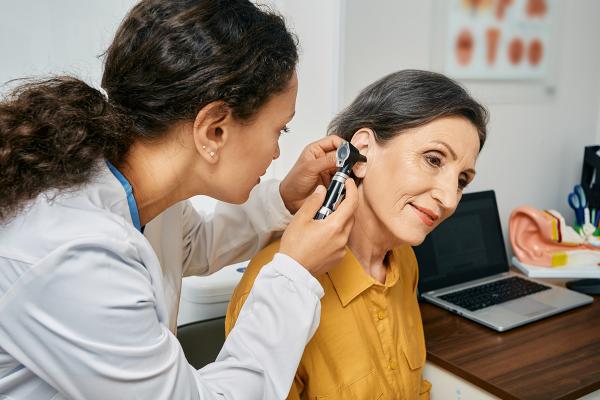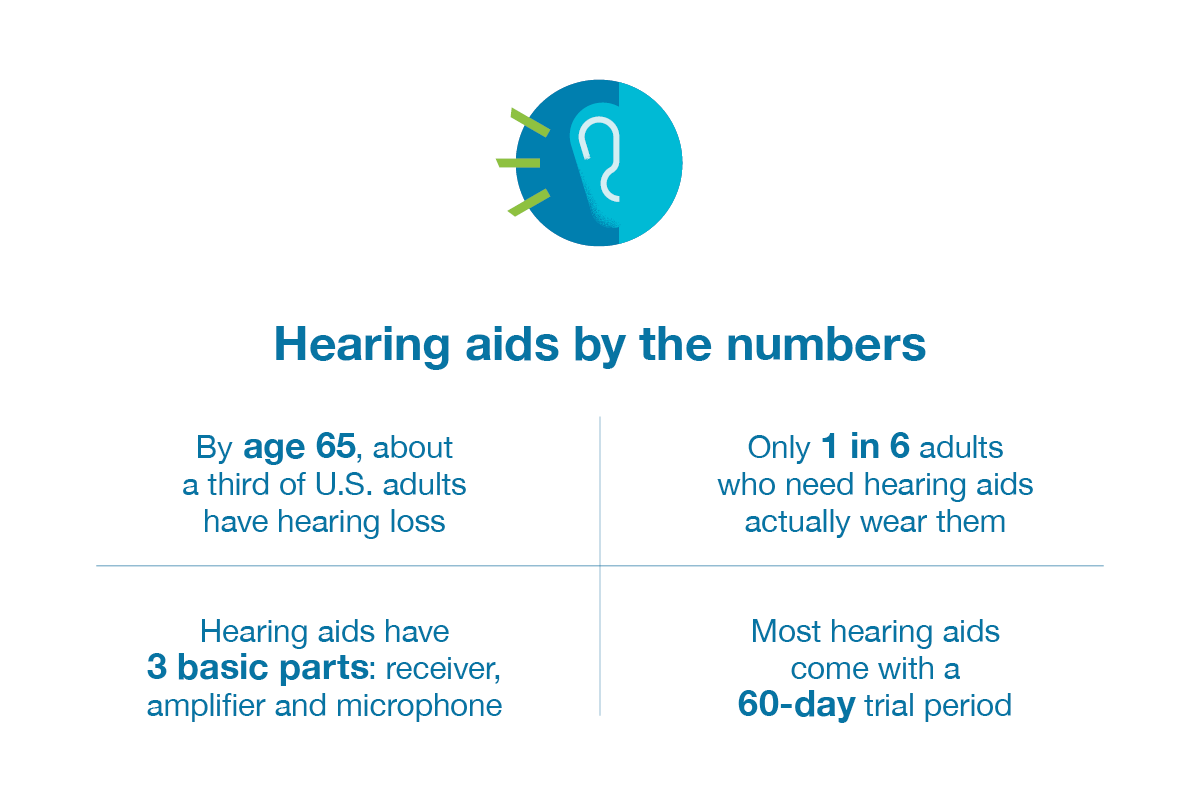
EPIC Hearing Healthcare helps members access hearing exams, hearing aids and more. Sign in to learn more and check eligibility.
These devices can improve your hearing — and your health — in lots of ways. Here are the basics.

Do you find yourself turning up the TV, asking family and friends to talk louder, or saying What? all the time?
Many people start noticing hearing problems as they age. And by the time they turn 65, about 1 in 3 adults in the United States have hearing loss.1 Hearing aids can help. But only about 1 in 6 adults who need hearing aids actually wear them.2
Those hearing aids could be life-changing, says Noelle Paradis, Au.D. She’s an audiologist at Cheshire Medical Center/Dartmouth-Hitchcock in Keene, New Hampshire. “People tell me they’re not struggling as much and their partner is happy because they can hear each other,” she says. “Some break down in tears and tell me it’s really made a difference in their life.”
Read on to find answers to common questions about hearing aids.

EPIC Hearing Healthcare helps members access hearing exams, hearing aids and more. Sign in to learn more and check eligibility.
Some signs your ears aren’t working as well as they used to:1
Does that ring a bell? If it does, it may be time to take action. You can start by talking to your primary care provider about a hearing exam.1 They may give you a basic screening or refer you to a specialist.
Think you’d like to meet with a hearing care professional first? You don’t need a referral to request a hearing exam and consultation with EPIC Hearing Healthcare. Hearing care professionals, which includes audiologists, hearing aid dispensers and hearing instrument specialists, specialize in treating hearing loss.3
At a hearing exam, a hearing care professional will find out how you respond to words and other sounds at different volumes, from very loud to super soft.4 They’ll see if you can hear sounds at different pitches. (A child’s voice is an example of a high pitch, while thunder has a low pitch.) And they’ll check whether you can hear even when there’s lots of background noise, such as at a busy restaurant or a train station.5
They can also pick up on damage to the nerves that carry sound signals from your inner ear to your brain.6 That can happen because of aging. Or it could be a result of years of exposure to loud sounds, such as rock concerts or noisy machinery at work. Or it may happen because of an illness you’ve had or a medication you’ve taken. (Reminder: Never stop taking a medication without talking to your primary care provider first.)
You can also take a preliminary online test. While it may not give you official results, it may help you decide whether to get a comprehensive exam.
Whatever the reason for your hearing loss, your hearing care professional will talk with you about what you can do. Often, the solution is hearing aids.
There are plenty of hearing aid options available today. Here’s what you need to know.
The latest hearing aids are almost invisible. Embarrassed about hearing loss and hearing aids? That’s a big reason why people put off getting them, according to the National Council on Aging.3 But chances are, your family and friends can already tell that you’re having trouble hearing. And they probably miss having conversations with you.
Plus, today’s newer, smaller hearing aids are easy to hide. They fit right into and behind your ear — and you have to really look to spot them.
Hearing aids do help you hear better. Hearing aids are tiny sound systems with three basic parts: microphone, amplifier, and speaker.7 They receive sounds from the world around you through a microphone, which sends sound waves to an amplifier. The amplifier boosts the strength of the signals. These signals are then sent to a tiny speaker in your ear.7
Hearing aids also use technology to mix sounds so they can better mimic the way people hear naturally. They can help reduce background noise, for instance, so you can hear conversations better.
In some hearing aids, the microphone, amplifier and other electronics are in a case that rests behind your ear, with the speaker (also called the receiver) inside your ear.8 In other hearing aids, all the components go right inside your ear. Most hearing aids are rechargeable, but some are powered by batteries that you can replace.

You can find a hearing aid that’s right for you — and your lifestyle. Hearing aids come in many different styles. Your hearing care professional can help you decide which is best for you. Your choice will depend on your answers to questions like these, say experts:7
Once you and your hearing care professional have figured out what might work best for you, it’s time to think about hearing aid styles. There are two main types. One type rests behind the ear. The other sits inside your ear.
Each style has pros and cons, as listed here, but at your appointment, your hearing care professional will help you pick out the right pair for your needs.
Hearing aids that rest behind the ear:
Hearing aids that go inside the ear:
If you're a member of EPIC Hearing Healthcare, you get up to 3 follow-up visits at no extra cost — and 60 days to try out your new prescription hearing aids. Learn more.
Hearing aids are changing all the time. Chalk it up to new technology and better design. New models make it easier to hear. Plus, they improve the quality of what you’re hearing. Some of common features include:
Noise reduction: Available on most hearing aids, this feature softens background noise, such as wind or restaurant noise. That makes it easier to hear conversations or other sounds.8
Directional microphones: These increase the volume of speech and sounds coming from certain directions, such the ones from the person facing you.8
Wireless/Bluetooth connectivity: This connects your hearing aids to your smartphone, computer, TV or other digital devices. That lets you hear those devices through your hearing aids.8
Feedback suppression: This stops whistling or squealing sounds.9
Wireless connection to smartphone apps: Many hearing aids connect wirelessly to an app you download to your smartphone. You can change the volume, turn special features on and off and change other settings — all on your phone.10 And some even come with activity and wellness trackers.
Tinnitus-reducing sound generators: Some hearing aids have a feature that produces sounds that help minimize ringing or buzzing sounds from tinnitus.11 Tinnitus is when you hear a ringing sound in your ear.
Rechargeable hearing aid: Most new hearing aids are powered by rechargeable batteries rather the disposable ones.12 That’s a big plus, since tiny hearing aid batteries are difficult to insert and remove. But disposable batteries may be a better choice if you tend to forget to recharge your devices or if you use up a lot of power by streaming music, TV or other audio through your hearing aids.12
Over-the-counter hearing aids became available online and in stores in 2022. They’re an option for adults ages 18 and older with mild to moderate hearing loss. The U.S. Food and Drug Administration approved them to help more people with hearing loss get help.13
You can buy over-the-counter hearing aids without a hearing exam, prescription, or supervision from a hearing care professional.
Bottom line: The first step to better hearing is determining — with your hearing care professional — what your needs are. With all the new hearing aids that are available today, you’ll be able to find one that works well for you — and your lifestyle.
Sources
Information is for educational purposes only and is not a substitute for the advice of a licensed medical provider. Consult your provider prior to making changes to your lifestyle or health care routine.
Hearing aids purchased in the Silver technology level will receive 1 follow-up visit.